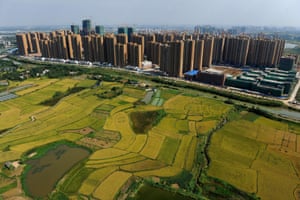Meet the ecomodernists: ignorant of history and paradoxically old-fashioned

Photograph: Hector Retamal/AFP/Getty Images
Beware of simple solutions to complex problems. That is a crucial lesson from history; a lesson that intelligent people in every age keep failing to learn.
On Thursday, a group of people who call themselves Ecomodernists launch their manifesto in the UK. The media loves them, not least because some of what they say chimes with dominant political and economic narratives. So you will doubtless be hearing a lot about them.
Their treatises are worth reading. In some important respects they are either right or at least wrong in an interesting way. In other respects … well, I will come to that in a moment.
With the help of science, technology and development, they maintain, human impacts on the natural world can be decoupled from economic activity. People can “increase their standard of living while doing less damage to the environment.” By intensifying our impacts in some places, other places can be spared. Through reduced population growth, the saturation of demand among prosperous consumers and improved technological efficiency, we can become both rich and green.
There seems to be some evidence that such transitions could be taking place. In the UK, for example, Chris Goodall, drawing on government figures for raw material consumption, has proposed that we might have reached “peak stuff”. Despite the resumption of economic growth, we appear to be using fewer material goods.
I don’t dismiss the possibility that this represents a real transition. But in the same period (2000 – 2012), incomes have stagnated while the cost of rents and mortgages has rocketed. Perhaps we simply have less spare money than we had before. If so, we can expect the shift to last for only as long as extreme inequality and an economy dominated by rentiers persist. To judge by the way things are going, this might be quite a long time.
And even if it is correct, can the living world weather this trajectory? If, as the manifesto anticipates, all the world’s people follow this presumed curve – their consumption rising until it matches ours, before it peaks and falls – the load imposed on the planet’s living systems before the expected transition occurs is likely to be horrendous.
So far, so interesting. In these respects ecomodernism is challenging, provocative and a useful part of the cut and thrust of environmental debate. But then this polite (if utopian) vision takes a dramatic swerve. It’s not just that economic activity should be decoupled from human impacts. Human beings should be decoupled from the land, through a massive and rapid urbanisation.
Of course, such processes are happening anyway, but the ecomodernists make it clear that they would wish away almost the entire rural population of the developing world. The US trajectory is the ideal to which they aspire: “Roughly half the US population worked the land in 1880. Today, less than 2 percent does.”
This hope appears to be informed by a crashing misconception. The ecomodernists talk of “unproductive, small-scale farming” and claim that “urbanisation and agricultural intensification go hand in hand.” In other words, they appear to believe that smallholders, working the land in large numbers, produce lower yields than large farms.
But since Amartya Sen’s groundbreaking work in 1962, hundreds of papers in the academic literature demonstrate the opposite: that there is an inverse relationship between the size of farms and the crops they produce. The smaller they are, on average, the greater the yield per hectare.
The most likely reason appears to be that small farmers and their families apply a lot more labour per hectare than large farmers do. The ecomodernists seem to have confused low labour productivity with low land productivity; a major and highly consequential mistake. From the ecological point of view, the metric that counts is land productivity: the less land you require to produce a given quantity of crops, the better.
In areas with little work, low labour productivity isn’t necessarily a bad thing either, as it ensures that large numbers of people are employed, even though the pay is often very poor.
So what happens to those who were working in “unproductive, small-scale farming”? The manifesto prescribes the following:
“A growing manufacturing base has long been a crucial way to integrate a large, low skilled population into the formal economy, and increase labour productivity. To grow more food on less land, farming becomes mechanised, relieving agricultural workers of a lifetime of hard physical labour.”
Former smallholders, in other words, having left the land, will find employment in the formal economy, in urban jobs created by others. But it seldom works like this.
The economic miracles in South Korea, Taiwan, Japan and (with a long delay caused by Mao’s Great Leap Backwards) China were built on the back of land reform, that distributed land formerly owned by a tiny elite to a much wider proportion of the population. In these nations, people used the money they made from farming to diversify into small-scale industry. Their economic transformation was not handed down from on high but built up from below.
In many other parts of the developing world, rural depopulation has resulted not in a smooth transition to the formal urban economy, but in a highly precarious existence on the economic margins, and a reliance on the informal economy, much of which remains connected to family businesses in the countryside. What the economodernists describe as “relieving agricultural workers of a lifetime of hard physical labour” is experienced by millions as underemployment and desperate insecurity.
For all its talk of “the liberal principles of democracy, tolerance, and pluralism”, the ecomodernist agenda resonates with a long history of such proposals, from the enclosures in England and the Highland clearances in Scotland, the colonial seizures of land in Kenya and Rhodesia, the Soviet dispossessions and the villagisation in Ethiopia to the current theft of farmland in poor nations by sovereign wealth funds and the rich world’s financiers.
The ecomodernists are intelligent people, who have a good grasp of technology and certain fields of science, but their apparent ignorance of all that went before and all that lies beyond disturbs me. The poor of the world have long been subject to remote and confident generalisations by intellectuals of this stamp, and have suffered gravely as a result.
Nor does their claim that mass urbanisation reduces our assault on the natural world necessarily hold up. The manifesto maintains that:
“Cities both drive and symbolise the decoupling of humanity from nature, performing far better than rural economies in providing efficiently for material needs while reducing environmental impacts.”
A recent paper in the Proceedings of the National Academy of Sciences shows that in the megacities now swelling across much of the developing world, consumption appears to be higher than average. The 7% of the world’s population living in these places consumes 9% of its electricity and 10% of its petrol and produces nearly 13% of the world’s waste.
As Mark Bessoudo notes in the magazine Sustainable Building and Design:
“It turns out that while density does equal efficiency, “megacity” does not necessarily equal density. Megacities do encompass those places that we typically associate with dense and culturally vibrant urban centres: New York City, Tokyo, London. But what’s not often taken into account is the fact that to keep them running, these cities also require surrounding areas such as industrial lands, ports, suburbs. In other words, the environmental benefits of a city’s dense urban core can be outweighed by the resource-inefficient, yet essential, areas on its periphery. They are, in fact, two sides of the same coin.”
It also seems pretty clear that the richer and more urbanised nations become, the less their people care about their environmental impact. The annual Greendex survey shows the people of the poorer nations consistently displaying greater concern about the impacts of their consumption, even though they tend to consume far less than the people of the rich nations.

A recent YouGov survey reveals that the people of China, Malaysia and Thailand are much less likely to deny the need for action on climate change than the people of the US, UK, Norway, Finland, Sweden and Germany.
But the problem with ecomodernism runs deeper than this. There is no attempt in the manifesto to interrogate the concept of modernisation, to determine what it means and what it doesn’t, to examine its problems as well as the benefits it delivers. Instead there appears to be a crude and unexplored assumption that people working in the formal, urban economy are modern, while those on the outside are not.
As Oscar Wilde warned, “nothing is so dangerous as being too modern; one is apt to grow old fashioned quite suddenly”. Their conception of modernisation and modernity is, essentially, a 19th century construct: people like us are modern; people like them are not. Modern is good, unmodern is bad, so they need to be more like us, and we can show them how.
The closest thing to a definition of modernism they offer is this:
“The long-term evolution of social, economic, political, and technological arrangements in human societies toward vastly improved material well-being, public health, resource productivity, economic integration, shared infrastructure, and personal freedom.”
Which would all be wonderful, but unfortunately bears little relationship to the real impacts of the processes they wish to accelerate.
As Chris Smaje argues, in one of the most interesting essays I have read this year, published on the Dark Mountain website, “modernisation” of the kind they celebrate may have liberated many people from bondage, oppression and hard labour, but it has also subjected many to the same forces.
“A word you won’t find in the Ecomodernist Manifesto is inequality. … There is no sense that processes of modernisation cause any poverty. … There’s nothing on uneven development, historical cores and peripheries, proletarianisation, colonial land appropriation and the implications of all this for social equality. The ecomodernist solution to poverty is simply more modernisation.
“… From ancient Mesopotamia to modern China the evidence is clear: development implies underdevelopment, material wealth implies material poverty, freedom implies slavery and so on. These couplets are not two ends of a historical process, with modernisation ringing the death knell for the misery of the past, but contradictions within the modernisation process itself.”
His second, devastating essay on the unexamined premises of ecomodernism is also worth reading.
Of course we should make the best possible use of science and technology, and assess our environmental options as empirically as we can. Of course we should embrace what is good and useful and progressive about modernity, however that might be defined. Of course we should challenge and contest the wishful thinking that all too often dominates.
In this respect the ecomodernists provide a useful service, provoking us to examine our prejudices. But their generalisations, their ignorance of history, their own unexplored prejudices and an astonishing lack of depth all contribute to a worldview that is, paradoxically, nothing if not old-fashioned.
